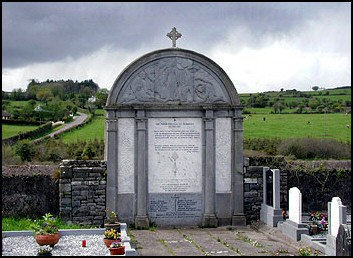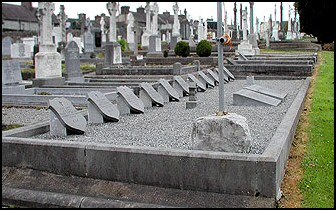|
Major Setback For East Cork I.R.A. at Clonmult (Irish War of Independence - First Cork Brigade) |
|
The burnt out shell of the house where twelve East Cork volunteers were shot dead by British forces in 1921. The greatest loss of life incurred by the
Cork I.R.A. occurred at Clonmult, seven miles north of Midleton, where almost
the entire In January 1921, the
|
|
On the Sunday afternoon the Volunteers prepared
their equipment, ready to leave at As five men, led by the acting 0/C Jack
O'Connell, lined up for a desperate break-out, heavy fire was opened up by the
troops outside. In the dash from the bullet-riddled cottage Michael Hallahan
was mortally wounded before he got any further than the doorstep, Richard
Hegarty fell as he sought cover behind the fence in front of the house and
Cobh-man James Ahem was killed when he tried to jump a fence some 200 yards
from the house. Jeremiah O'Leary was badly wounded but managed to get back to
the farmhouse. Only Captain Jack O'Connell was successful in getting through
the withering fire of the British. O'Connell frantically tried to organise
reinforcements for his trapped comrades. He contacted three local Volunteers,
one of whom raced to Conna his bicycle, some six miles from Clonmult, where the
North East Cork column was located. Meanwhile the battle raged relentlessly
around the cottage. The British were the first to be reinforced when, within an
hour of the start of the battle, a number of Black-and-Tans arrived. After a
two-hour fight the thatch on the cottage was set alight by the Black-and-Tans
and troops. With a blazing roof over their heads, the trapped Volunteers tried
to make a breach in the gable and soon a narrow opening had been made.
Volunteers Glavin and O'Leary tried to force their way through the narrow
passage, but almost immediately fell back with head wounds. With no other means
of escape possible, the men in the cottage had no option but to surrender.
Before leaving the house, they destroyed their rifles.
When the Volunteers emerged from the house with
their hands up, the first seven to come out were immediately mown down by the
waiting Black-and-Tans. While lying on the ground volunteers Liam Aherne,
Jeremiah Aherne, David Desmond, Christopher Sullivan, Donal Dennehy, Joseph
Morrissey and James Glavin (from The North East Cork column, upon hearing of the
plight of their In addition to those who had been murdered, nine
volunteers had been captured by the troops. They were tried by court-martial
and sentenced to death. The death sentences imposed on O'Leary, Terry, Walsh,
Garde and Harty were later commuted and Captain Higgins, recovering from severe
wounds, was spared by the advent of the truce in July. However, It is believed that the men at Clonmult were
given away by an informer. A British ex-serviceman, out trapping rabbits at
Clonmult, had noticed the presence of the column in the farmhouse and informed
the British authorities. When he was subsequently captured and court-martialled
by the North East Cork column, the man is said to have confessed to his
treachery.
|
||||||||||||||||||||||



